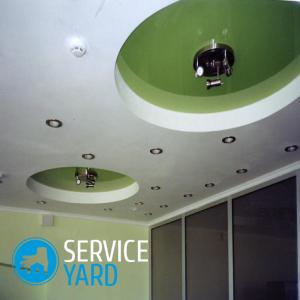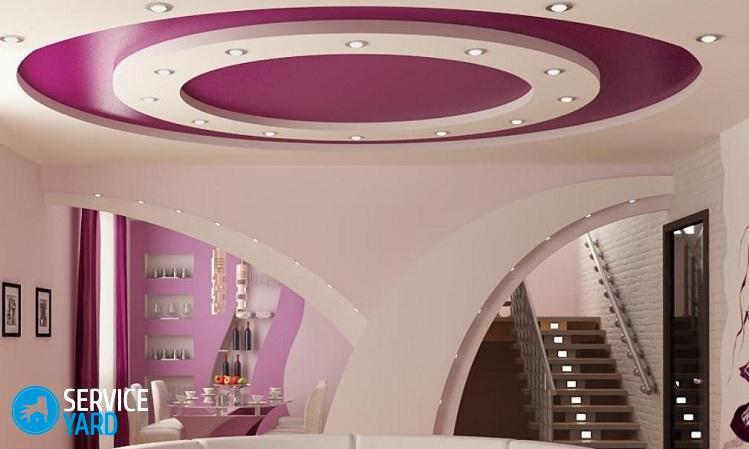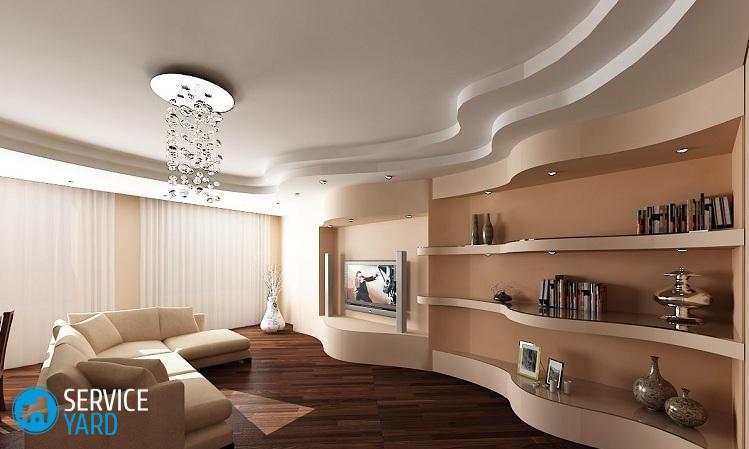How to paint the ceiling of drywall with your own hands?

Suspended drywall constructions have become very popular lately. Many owners when carrying out repairs in the apartment prefer drywall, due to the good performance characteristics of the material. The construction of drywall allows you to create an excellent design, while hiding the irregularities of the base surface. However, any material requires finishing, and its simplest form is painting. Today we will focus on how to paint the ceiling of drywall with our own hands, explain in detail all the features of this process.
to contents ↑How to paint a plasterboard ceiling?
Plasterboard designs allow you to create multi-level original compositions with perfectly even surfaces, place open fixtures and hidden lighting points, thereby giving the ceiling a unique design look.
However, all this can be achieved only under certain conditions:
- Preparatory work was carried out efficiently and carefully.
- Materials for painting high quality.
- The technology of painting the ceiling is followed.
Important! The quality of painting depends on how well all stages of the work are carried out, since even the most insignificant errors and shortcomings are always noticeable on the surface of the ceiling.
Let us consider in more detail the stages of the painting.
to contents ↑GKL ceiling surface preparation
The ceiling before painting should be perfectly even, for this it is necessary to carry out the following measures:
- Walk with a spatula over the entire surface. If the tool touches the self-tapping screw, then screw it “flush”. If - on the contrary, the hardware is screwed too deep (more than 1 mm), screw it out and screw it side by side.
Important! Be sure to remember the location of the hole in order to putty it later.
- Primer the entire surface of the ceiling. The primer will significantly improve the adhesion of the putty and increase the resistance of the material to moisture.
- Paste the seams with special self-adhesive tape. The tape will create a putty skeleton to subsequently prevent it from cracking.
Important! The tape can be of several types - paper, sickle (mesh fabric), polymer. Manufacturers recommend a paper version, but in practice they most often use a mesh fabric with an adhesive base. Serpyanka is glued directly to drywall. To prevent the putty material from cracking, we recommend sticking 2-3 layers of tape. Seal each layer with putty.
- Sand the ceiling. The dust formed cannot be completely removed with a broom or a damp cloth. Anyway, it will clog into microcracks that are not visible to the eye, so it is necessary to prime the surface again.
Important! During sanding, be sure to wear safety glasses and a respirator to protect your eyes and respiratory system from dust.
- Primer the surface of the ceiling again. If this is not done, then the paint may collect in lumps, which will be clearly visible on the dried ceiling.
What paint to paint a plasterboard ceiling?
The choice of paint should be attributed with all responsibility.An inexperienced buyer, going to the store for dye, often keeps in mind only his preferred color, forgetting about other important qualities of the material. Here are just a few of them.
Decorative
The main function of the paint is to give the ceiling an aesthetic appearance. The classic and most familiar for the ceiling is white. Many masters prefer to use the base color, and tinting as necessary is done using special pigment additives.
Different degree of gloss
Depending on the component composition, the paint may be:
- Matt This coating is ideal for ceiling surfaces. Matte paint will visually expand the room, perfectly hide defects and small level differences.
Important! On the operational side, such a coating has worse performance, since it will be much more difficult to clean the stained area from the surface.
- Semi-matt. It occupies a middle position, combining the advantages and disadvantages of matte and glossy paint.
- Glossy. The material is beneficial in terms of surface care. It is easy to remove settled dust and stains from it. The coating is more resistant to abrasion and the use of detergents.
Important! Glossy coating is able to show all the flaws of the painting. The play of reflected light makes even very slight flaws noticeable.
- High gloss. The coating is very shiny and enhances all the advantages and disadvantages of glossy paint.
Texture
The paint can be absolutely even or have textured inclusions that give the surface decorative relief properties.
Important! Textured paint is more often used for walls than for ceilings.
Moisture resistant
Regardless of glossiness, the coating can be washable or not. Washable materials are more expensive, it is advantageous to use them in rooms where the ceiling area is small and the concentration of evaporation is maximum, for example, in the kitchen or in the bathroom.
Important! To paint the ceiling of drywall, it is better to take moisture-resistant solutions.
Hiding power
The ability of the paint to give the surface a selected shade even on a contrasting base. The opacity is determined by the number of layers applied for an absolutely even background.
Important! High-quality material, to paint the ceiling of drywall with your own hands, it is enough to apply in two layers.
Paint consistency
Too thin a fabric will make ceiling work extremely difficult and cause a lot of loss. Overly viscous material is difficult to work with. And if a thick paint can be brought to the desired state by adding a solvent or water, then with liquid paint the situation is much worse.
Drying speed
This is an essential criterion when choosing a material, since the drying speed determines the performance of painting work. The shorter the drying time, the faster you can apply the next coat of paint or move on to the next stages of ceiling decoration.
Important! The passport documentation usually indicates the average drying time under normal conditions of temperature and humidity.
Safety for human and animal health
The coloring component, solvent and additional ingredients of the material should not pose any environmental threat and should be absolutely safe for the health of others. At the same time, the material should prevent the emergence and spread of various microorganisms (mold, bacteria, fungus). In addition, the painted surface must have pronounced fire-fighting qualities.
The ability to carry out free steam exchange
In other words, the paint should “breathe”. Otherwise, condensation will accumulate on the surface, which will lead to serious domestic inconvenience and untidiness of the appearance of the ceiling.
Thixotropy property
This characteristic is indicated on the jar with the material and lies in the ability of the paint to change the density with mechanical stirring and quickly gain viscosity at rest. Such material gives few streaks when used, but its cost is high.
Useful Tips:
- When choosing a material to paint a plasterboard ceiling, consider those properties that may obscure surface imperfections. If it is even, then you can use any paint, including glossy. And if there are some errors in the putty, then give preference to matte, which will hide the defects.
- To make the ceiling glossy, use enamels. But remember that in this case the drywall must be prepared perfectly for painting, as the enamel is able to emphasize all surface defects.
Having familiarized ourselves with the main characteristics and parameters of the material, we will proceed directly to the choice of paint for the ceiling from GKL.
to contents ↑Choosing the right paint
Among modern means for painting, the most popular for GCR are the following.
Alkyd enamel
In terms of its performance, it is similar to oil. The main difference is in the use of solvent. The painted surface successfully resists many external influences: changes in temperature, humidity and ultraviolet, but over time, inevitable fading occurs.
Important! Paint, although it is vapor permeable, but its indicator is far from ideal in residential premises. In addition, the material is unsafe in terms of flammability.
Water dispersion paint
This is one of the best options for paint yourself to paint the ceiling of drywall with your own hands:
- All components of the material are absolutely safe in environmental terms.
- On drywall, such a material forms a film with high permeability, and a matte surface will hide all defects, visually raise the ceilings and expand the space.
- The most important advantage is the speed of drying. Within 2 hours, the surface dries completely without an unpleasant odor.
- The paint has high abrasion resistance and lends itself to wet cleaning.
Water-based paint
A water-based polyvinyl acetate-based paint (PVA) is one of the most inexpensive and most popular. It has virtually no odor, is easily washed off from hands and tools, has good adhesion and is absolutely harmless. Other materials easily fall on it, which makes it easy to repaint the surface.
Important! The main disadvantage is poor resistance to abrasion and water (even after complete polymerization). But since the goal is to paint the ceiling of drywall, this is a perfectly acceptable option, especially for the living room, bedroom.
Silicone
The most modern and combining advantages of all other types of coating:
- The paint has a pronounced water-repellent effect and is practically not subject to contamination.
- The coating is extremely resistant to abrasion, caring for it is not difficult.
- Hiding power is beyond praise, the paint is able to tighten cracks up to 2 mm wide.
- The coating film is dense, but with good vapor permeability.
- The paint is absolutely harmless both in liquid and in polymerized form.
- In terms of durability and preservation of the original appearance, silicone paint is the undisputed leader.
The only drawback is the high price, so it is rarely used for painting large areas.
to contents ↑Important! Refrain from using oil paint, since such a composition forms a dense film on a surface that does not allow air to pass through. In addition, the operational life of the oil coating is only 3-4 years, and updating the surface after such paint will be quite difficult. A complete cleaning of the surface will be required, since no other paint will lay on top of the oil.
How to paint a plasterboard ceiling?
There are only three tools with which you can paint the ceiling of drywall:
- Brush.Brush painting the entire surface of the ceiling is quite expensive, long and difficult. The brush is usually used for painting corners and hard to reach places.
- Roller. Paint roller is the best option. Working with him is convenient, economical and simple. The paint is applied to the surface with a roller evenly and without drips.
Important! You only need to use a wool roller (with a long pile), since the foam tool leaves bubbles on the surface and slips, leaving behind “bald spots”, and the velor absorbs a little paint, so unpainted areas can remain on the surface.
- Spray gun. Spray gun is the most economical option. The only negative is not always at hand and is expensive. In addition, to work with a spray gun you need experience. If you are careless about this process, then you can get a lot of dirt not only on the floor and walls, but also on clothing.
In addition to the basic tools and the paint itself, for work you will need:
- Construction mixer and a special nozzle for it to mix paint.
- Paint bath.
- Steady ladder.
- Gloves, safety glasses.
- A piece of plywood or a paint tray.
Once you have decided what to paint the ceiling of gypsum board with your own hands, proceed to the process itself.
to contents ↑GKL ceiling painting process
First of all, it is necessary to understand that painting work has its own specific rules, without observing which, you can ruin the whole process.
General rules
In order not to have to start all over again, listen to the following recommendations:
- Do not interrupt the painting process under any circumstances. Otherwise, an unevenly colored coating will turn out and the whole pattern will be violated, which will significantly worsen the appearance of the ceiling.
- Use only one tool for the job. Do not change or overturn the roller during operation. Use it only in one direction.
- Do not return to the painted area, which has already begun to dry out. This will violate the picture of the overall pattern and jeopardize the uniformity of the application of paint, and after the paint dries, a noticeable spot will appear on the surface.
Staining technology
The process of painting the drywall structure itself is quite simple if you follow this instruction:
- Prepare the paint according to the recommendations and proportions of the manufacturer. In one container, mix the compositions of paints that are in different banks, as in different batches the shade may vary.
Important! If you have prepared a water-based paint, then it is advisable to strain it using nylon tights.
- Set the ladder, prepare all the necessary tools.
- Start painting from any corner by the window. First paint over the junction of the ceiling and the wall with a brush.
- Paint all the corners with a small brush from the window to the exit around the perimeter. Paint at a constant speed, evenly and accurately. After the work with the brush is completed, proceed to work with the roller.
- Pour paint into the tray and dip the roller completely into the container. The pile of the tool should be completely saturated with the coloring compound.
- Roll the roller in the tray.
- Wait for excess paint to drain. Without pressing, slide the roller several times over a piece of plywood.
- Rub the paint evenly with a roller over the surface of the ceiling. This is best done along the room. Paint a strip of 0.7-1 m from the window to the opposite side.
- Apply paint on the second strip. The stripes should face each other with an overlap of 10 cm.
- Paint the surface of the ceiling completely.
- Wait for the coating to dry completely, wipe it with a clean, damp cloth and begin to apply the next coat. The minimum number of layers is 2. Sometimes with poor-quality putty or in the presence of greasy spots on the surface
you have to use 3-4 layers. - After the drywall has completely dried under the light, inspect the entire surface and evaluate the quality of the painting. If you find defects and irregularities, then walk on the surface with another layer.
Useful Tips:
- If you paint the ceiling in three layers, then stick to this scheme: the first layer - apply vertically, the second - horizontally and the third - vertically.
- When spraying, protect walls and floors with sheets of paper or newspapers.
- While the paint is drying, close the room from drafts, turn off the ventilation and heating.
- If, according to the design plan, the ceiling coverage should change, then use masking tape to mark the borders of the same color.
- Spread the second coat to avoid overlapping joints. Apply the paint perpendicularly and start the painting process on the other side of the ceiling.
- If specks, hair and spools adhere to the surface during operation, immediately remove them.
- Place the output of communications and decor items around with jerky movements to avoid noticeable marks.
Stock footage
We hope that the detailed information contained in the article will help you easily cope with painting the ceiling. Take everything into your own hands, listen to our advice, and the ceiling will turn out to be smooth and high-quality, and as a bonus - saving a tidy sum for the services of a master. Easy work and comfort in your home!
- How to choose a vacuum cleaner taking into account the characteristics of the house and coatings?
- What to look for when choosing a water delivery
- How to quickly create comfort at home - tips for housewives
- How to choose the perfect TV - useful tips
- What to look for when choosing blinds
- What should be running shoes?
- What useful things can you buy in a hardware store
- Iphone 11 pro max review
- Than iPhone is better than Android smartphones






